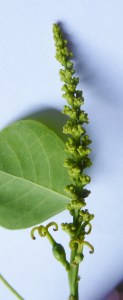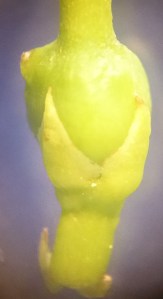
Triadica sebifera is commonly known as Chinese tallowtree or candleberry tree. The tree is native to eastern Asia- eastern China, Taiwan and Japan.
It is a deciduous tree which sheds their leaves in winter. The leaves are ovate and in heart shape, with smooth edges, pointed tips and are arranged alternately along the branches. The colour is bright green on the upper surface and paler on the lower surface.

In spring, small flowers occur in a terminal spike-like inflorescence up to 18 cm long. They are very tiny, greenish yellow in colour. The flowers have nectar and are attractive to bees and other insects.
The pistillates (female flowers) are located in the lower part of the inflorescence. The staminates (male flowers) occur in the upper part of the inflorescence.






The green leaves change colour in autumn. Different shades of yellow, orange, red and purple-red are displayed before they shed from the branches in winter (June in Sydney). The colours are spectacular.

During summer and autumn, the ovaries of the pistillates develop into fruit capsules. As the capsules mature, their colour changes from green to dark brown. The capsule walls splits open exposing three globose seeds, white in colour.





The bark is rough, greyish brown in colour and with furrows running from top to bottom in a rectangular pattern.

Economic uses of the trees
The waxy coating of the seeds is used to make candle and soap. The leaves can be used as herbal medicine to treat boils.
The nectar provides good honey for beekeepers.
It is also useful in the production of bio-diesel as it is the third most productive vegetable oil producing crop.
Chinese tallowtree is sold in nurseries as an ornamental tree. It is a popular street tree in many cities eg Sydney. The tree is famous for its spectacular autumn foliage.
Acknowledgements
I would like to thank Mr Andre Orme of the Royal Botanic Gardens, Sydney for his kind advice and guidance.
Bibliography
https://en.wikipedia.org/wiki/Triadica_sebifera
http://weeds.dpi.nsw.gov.au/Weeds/Details/38
Clarence Valley Council (2013) Chinese tallow tree control sheet. Available at http://www.clarence.nsw.gov.au/cp_content/resources/Chinese_Tallow__2013.pdf
Crayn DM (2014) Triadica sebifera (L.) Small in PlantNET – – The Plant Information Network System of The Royal Botanic Gardens and Domain Trust, Sydney, Australia. Available at http://plantnet.rbgsyd.nsw.gov.au
https://plants.ifas.ufl.edu/plant-directory/triadica-sebifera/ (University of Florida) excellent video